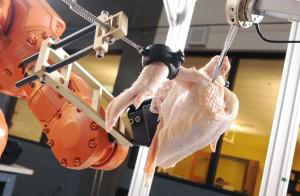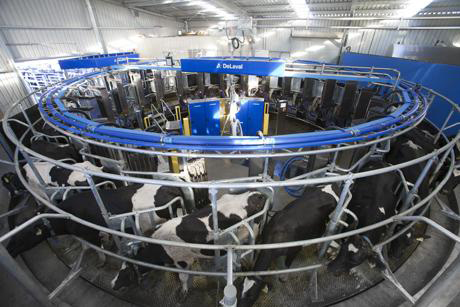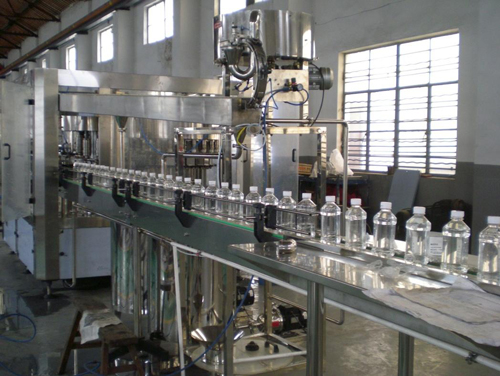Robotic sensory technology is now able to act in the same manner that a person does, adapting to the food manufacturing environment and utilizing vast amounts of information to give us some of the safest food in the world.
Len Calderone for | RoboticsTomorrow
Robots have been used in many industries for decades, but they are finally being utilized in food processing. The versatility of robots takes the human element from dangerous areas, such as food processing lines and their use makes the food supply safer.
.jpg)
The food processing industry combines an extensive diversity of products, packaging types and handling variations than almost any other industrial sector. There is a wide range of potential applications for robotics in food processing from the meat industry, where robots are used for cutting, sorting and packaging applications, to cheese production, where they stir curds, transfer cheese moulds, and turn, cut, portion, package and palletize the cheeses. Integrated sensors and measuring systems enable the simple implementation of complex processes.

Blocks of cheese arrive on wooden planks at the robot picking area. The special gripper allows the cheese blocks to be picked and placed onto a conveyor for further processing.
Working in a freezer or refrigerated storage boxes is not conducive to humans, but robots can work in such places without ever needing a break. Cutting and trimming carcasses can be very dangerous work, where a moment of distraction could cause serious injury; but robots can wield heavy and sharp knives with absolute precision.
Human workers can taint foods with pathogens, whereas robots are considerably more sanitized, as they can be washed with high pressure water and solvents. Robots do not sneeze or get colds, reducing the propagation of germs and bacteria.
Production levels in many food processing plants vary during certain seasons, making it difficult to find workers, who will work only during peaks. There is a high turn-over of employees in the meat processing plants, because of the dangers and harsh working conditions. Some plants hire on a daily basis to replace the workers who leave.
Georgia Tech researchers have developed a system that uses advanced imaging technology and a robotic cutting arm to automatically debone chicken and other poultry products.

This robotic system is used for the intelligent cutting and deboning of a chicken, as it prepares to slice through the shoulder joint of a chicken, cutting close to the bone to maximize breast meat yield and ensuring food safety by avoiding creation of bone chips.
The system employs a force-feedback algorithm that can detect the transition from meat to bone, allowing the cutting knife to move along the surface of the bone while maintaining a constant force. Maintaining contact with the bone allows the knife to cut all the ligaments around the shoulder joint without cutting into the bone itself. A similar approach can be used for other parts of the bird where meat must be separated from bone.
For the faint of heart, I will not go further into the robotic processing of meat, but there are robots that can handle all aspects of the processing.
Only recently, due to increased market competition, operational costs, and safety requirements, vision-guided robots have been used to automate meat production processes. Today, automation systems are being deployed at numerous stages in the meat production procedure.
After the meat is cut and deboned, it is then sliced, packaged, and shipped to the customer. Vision-guided robots are speeding up these practices to make certain that the pieces are accurately portioned and cut, while packaging equipment is incorporating volumetric scanning systems.

Packaging system at Unilever for pepperoni sticks
The world's first commercial robotic milking rotary has been unveiled by Swedish dairy equipment company DeLaval at a pilot farm at Quamby Brook, Tasmania, Australia.
Featuring five robots, the rotary has a capacity to milk up to 90 cows per hour, enabling the robots to reach the cow from the side. With the use of laser technology, the robots focus a red light to determine the location of the cow's teats, clean them and attach the cups.

The first two robots clean and prepare the teats for milking, the second two attach the cups to the teats, and the last robot sprays the teats to disinfect them before the cows leave the platform.
Once the milking is done, robotic liquid filling and finishing systems get the product ready for market. These robots handle many types of bottles, vials, bags, and pouches with precision filling from micro liter to multi liter. The containers, once filled, can be closed using a screw cap, stopper, or crimp. They accommodate a variety of products; and deal with fill volumes, dispensing profiles, containers and closure types, making them ideal for clinical trials, full scale production and contract manufacturing.
SAMR Industries makes robotic bottle filling machines that automatically wash the bottles, fills them with liquids, such as beverage water, sauce, vinegar, and wine; and then caps them. The robot handles UV bacteria killing, plastic forming, date printing, fixed quantity filling, and sealing.

Industrial robots have emerged as a valuable packaging tool for food manufacturers, as the performance and user-friendliness of the robots has increased while costs have come down. Vision-assisted robots emulate the flexibility of human hand-eye coordination, and they perform a number of inspections for quality assurance. Many food companies have successfully applied robots in a wide variety of processes in the dairy, meat, baking, confection, frozen, snack, beverage, and produce industries.
These robotic applications have made it possible for food manufacturers to use new lightweight package designs, improve equipment effectiveness, reduce changeover time, eliminate change parts, reduce operating costs, and improve food safety and quality. Multi-case grippers achieve high throughput rates. After the cases are assembled on the in-feed conveyor, the robot transfers the cases, using a vacuum-actuated gripper, to the pallet.
Palletized products include bags, pouches, bottles, cans, totes, drums, pails, and rolls. With the accurate placement of items on the pallet the corners and edges of the cases are aligned for maximum stacking strength and minimal product damage during shipment.
Remtec Automation has an integrated case packing and palletizing system that includes a case erector, conveyers to move the cases, a robotic case loader, case sealer and case palletizer. The system can be designed to handle products in cartons, bags, clamshells or flow wrap.

Robotic palletizing can be seen in food processing industry with various end-of-arm-tooling styles, which allow the use of different types of palletization. Bag grippers capture a package and support it on the bottom, while suction and magnetic grippers handle more ridged items and grip them from the top. Robots are able to handle heavy loads and have horizontal and vertical reaches that allow cases to be palletized from varying distances.

Innovative Conveyor Concepts’ palletizing robot
Robots are good at routine and tedious tasks, which protect employees from repetitive strain injuries and make the employees available for more interesting jobs, preventing employee turnover. Robots can also carry out tasks that people are unable to do or find awkward, such as working in cold storage areas or reaching into ovens.
I expect that more robots will be involved in food production, involving recipe uploads, because of their ability to precisely measure ingredients. Also, because of the number of food recalls and infected foodstuffs, robots will play an important function, as their stainless steel parts are easy to clean and prevent the transfer of pathogens in the food line.
Robotic sensory technology is now able to act in the same manner that a person does, adapting to the food manufacturing environment and utilizing vast amounts of information to give us some of the safest food in the world.
For further information:
- http://www.foodprocessing-technology.com/downloads/whitepapers/
- http://www.icomst2009.dk/fileadmin/documents/ICOMST_Gudjonsson_PlenaryC_18082009.pdf
- http://search.abb.com/library/Download.aspx?DocumentID=9AKK105408A6279&LanguageCode=en&DocumentPartId=&Action=Launch
- http://source.theengineer.co.uk/production-and-automation/robotics-and-positioning/robotic-handling/white-paper-sanitary-robotic-food-packaging/2010747.article
The content & opinions in this article are the author’s and do not necessarily represent the views of RoboticsTomorrow
Comments (0)
This post does not have any comments. Be the first to leave a comment below.
Featured Product


